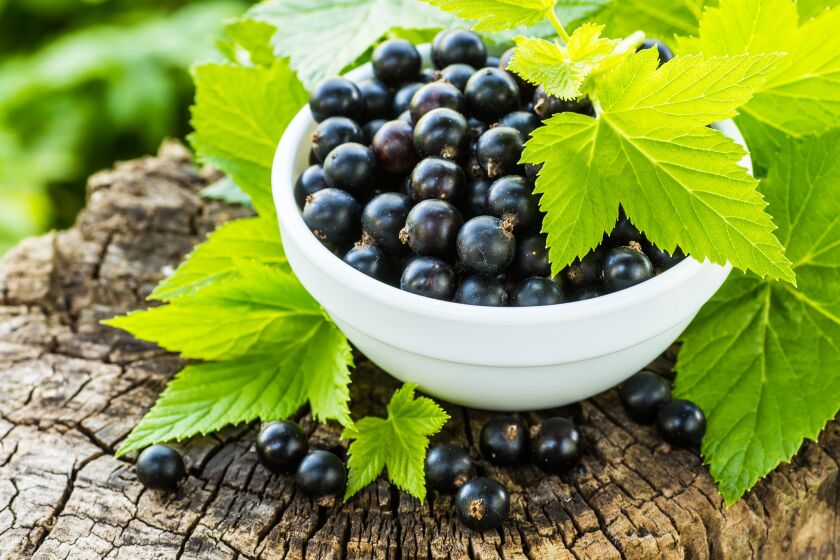In the quest for optimal nutrition, we’ve been told to try to “eat the rainbow.”
That means you should stock your plate with a wide range of fruits and vegetables representing the hues found in the rainbow. The more brightly vibrant and diversely colorful produce, the more likely it is that this diet is filled to the brim with vitamins, minerals and health-promoting plant compounds.
In particular, blue and purple fruits and vegetables should be included whenever possible.
These lovely items, though less common than orange, red or yellow produce, also aare loaded with nutritional goodness, being good sources of anthocyanins, which care antioxidant compounds that might help support brain function, improve heart health and help lower the risk of elevated blood pressure and certain cancers.
Here are seven powerfully delicious blue fruits and vegetables along with tips to include them in your diet:
Elderberries

Elderberries
stock.adobe.com
Why eat them: Evidence suggests that compounds in elderberries might support healthy immune cells and help battle cold and flu viruses. Concentrated elderberry extracts might help fight the flu, though this is still under investigation.
How to eat them: Elderberries can be eaten whole, as a juice, syrup or extract. If eating the whole berry, be sure to cook them first — raw and unripe elderberries can cause an upset stomach.
Blueberries

Blueberries
stock.adobe.com
Why eat them: This well-studied fruit is full of fiber, manganese, vitamin C and vitamin K and is low in calories. Blueberries are full of anthocyanins, and regularly eating them has been linked to the helping prevent heart disease, Type 2 diabetes, cancer and conditions of cognitive decline such as Alzheimer’s disease.
How to eat them: Blueberries can be eaten raw, added to cereal, yogurt or granola or baked into breads.
Concord grapes

Concord grapes.
stock.adobe.com
Why eat them: Concord grapes have higher amounts of antioxidant compounds than purple, red or green grapes. They’re full of antioxidants that might help support the immune system.
How to eat them: Concord grapes can be eaten raw or made into wine, juice or jam.
Black currants

Black currants.
stock.adobe.com
Why eat them: Diets rich in vitamin C can help protect against damage on the cellular level and against chronic disease including cardiovascular disease. Black currants are an excellent source of vitamin C, which has significant antioxidant properties. Vitamin C also supports wound healing, plays a role in the support of the immune system and helps maintain bones, teeth and skin.
How to eat them: Black currants can be eaten fresh, as dried fruit or preserved in jams or juice.
Blue tomatoes

Blue tomatoes.
stock.adobe.com
Why eat them: Also known as purple or indigo rose tomatoes, blue tomatoes are high in anthocyanin, which gives them their bluish-purple color. Diets rich in anthocyanins can help reduce inflammation, protect against heart disease and might help support eye health and brain health. Blue tomatoes also contain antioxidants like lycopene, which has been associated with a lower risk of heart disease, stroke and prostate cancer.
How to eat them: Add sliced blue tomatoes to sandwiches and burgers, in wedge shapes in entree salads or diced into a salsa or pico de gallo.
Purple carrots

Purple carrots.
stock.adobe.com
Why eat them: All carrots are a good source of vitamin A and C, potassium, dietary fiber and manganese. Purple carrots are a good source of anthocyanins — antioxidants that might help fight inflammation. Diets high in antioxidants and anthocyanins can help fight against oxidative stress — an imbalance between free radicals and antioxidants — and oxidative stress has been linked with cancer, heart disease, premature aging and cognitive decline.
How to eat them: Enjoy purple carrots raw, or add to a soup or stir fry.
Blue corn

Blue corn.
stock.adobe.com
Why eat them: Blue corn contains anthocyanins, the antioxidant compounds that can help support health benefits. Blue corn can have a higher protein content and lower glycemic index than yellow corn. Research from animal studies suggests that blue corn might also contribute to improvements in memory and might beneficially influence high density lipoprotein — good — cholesterol and help support the reduction of more harmful fats such as total cholesterol and serum triglycerides.
How to eat them: Cooked blue corn can be added to soups, stews, casseroles, salsas and salads.
Environmental Nutrition is an independent newsletter written by experts on health and nutrition.
"filled" - Google News
October 26, 2022 at 08:00PM
https://ift.tt/4SVB7xH
The beauty of blue foods — 'filled to the brim' with nutrients for good health - Chicago Sun-Times
"filled" - Google News
https://ift.tt/UDo6beZ
https://ift.tt/tJrjfT9
Bagikan Berita Ini














0 Response to "The beauty of blue foods — 'filled to the brim' with nutrients for good health - Chicago Sun-Times"
Post a Comment